Choosing a concrete mixer for home, summer cottages + reviews
To maintain order, even in a small area, concrete is constantly required: pour the posts for the fence, knead the mortar for the masonry, pour the foundation for the gazebo, shed, shed, pour the slabs for the path ... but you never know the housework. Stirring in the trough is physically long and hard. Therefore, many people think about purchasing a concrete mixer. And if there is a serious construction project ahead, and there is nothing to think about, this tool is simply necessary. One has only to say that a solution well prepared in a concrete mixer turns out to be 50% stronger than one made by hand (with the same composition of components). One thing remains: choose a concrete mixer.
The content of the article
Concrete mixer designs
To choose a concrete mixer, you need to familiarize yourself with the basic structures. There are two types of mixers: forced mix and gravity mixers. Forced ones consist of a stationary container, inside which mixing blades rotate. Due to the design features, they work only with solutions - without large aggregate, they also require more powerful engines, and, accordingly, consume more electricity. All this leads to the fact that they are used mainly by professionals.
For developers and for domestic use, gravity concrete mixers are more suitable. This is a barrel-shaped container, inside which strips-blades are welded. This container rotates around its axis and can change its position relative to the horizon. With an inclined tank, the most intensive mixing occurs. This design allows you to make both mortar (cement + sand) and concrete (cement + sand + gravel or other coarse aggregate).
There are two types of drives - gear and crown. Gearboxes are more reliable, but repairing them is a very difficult and expensive undertaking. If suddenly such a mixer breaks down, then it's easier to buy a new one. The crown structure breaks down more often, nevertheless, replacing the crown is a matter of a couple of hours and a relatively small amount of money (1,000-2,000 rubles, depending on the crown material). All this led to the popularity of wreath-type gravity concrete mixers.
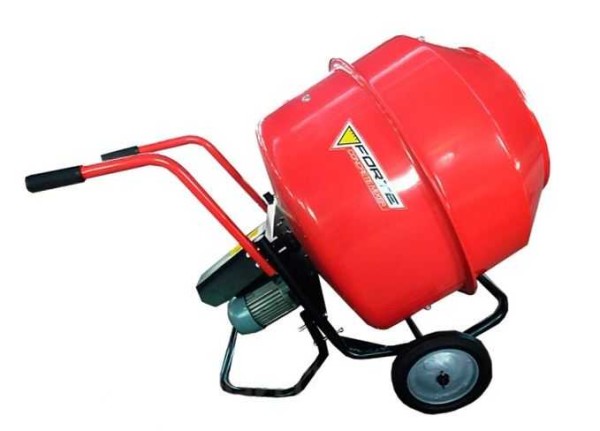
A geared concrete mixer usually has a characteristic design - the engine is located under the bottom of the tank
What to look for when choosing a ring concrete mixer
Choosing any tool is not easy. And in a concrete mixer, there are three different components that affect performance and durability: bed, tank and motor. And we must consciously choose all these parameters, and also take into account a bunch of nuances. Then choosing a concrete mixer will be easy.
Mixing tank (pear)
The first thing you have to decide is the volume of the mixing container. The range is very large: from 30-40 liters to 200-300 liters. The most popular concrete mixers among developers with a volume of 130-160 liters. But this is far from being a dogma. Someone prefers to have two 80 liter concrete mixers instead of one large one. But in general, for home use or for a summer residence, they buy mainly concrete mixers with just such tanks. They are optimal in performance, weight, allow both to carry out more voluminous work - pouring foundations, and more modest - concreting fence posts, for example, or mixing mortar for laying bricks, etc.
When deciding on the size of the tank, keep in mind that in reality you will receive about half of the declared volume of concrete.The thing is that when mixing, the container must be tilted. And the more dense you need the solution, the greater the angle of inclination will be - standing the concrete mixer almost does not mix anything. It is called gravitational because the solution adheres to the walls of the inclined barrel, is picked up by the blades, and then, under the influence of gravity, falls down. This is how mixing takes place. It is clear that you will not load the inclined container completely - half will simply fall out. Specific load sizes are determined later, during work. And you can focus on the average figures: thick concrete will be about 50% of the total volume, more plastic about 65%. The solution is even less (due to the presence of crushed stone, concrete mixes better).
When you are already choosing a concrete mixer "live", pay attention to the thickness of the tank walls. It is clear what is better - thicker walls. But a thick-walled tank means extra weight. So you will have to decide here which is more important - easier movement or a more reliable tank.
Motor power
After deciding on the volume, you need to decide what power the motor will suit you. Actually, how much concrete you get at a time also depends on the power of the motor. The more powerful the motor, the heavier the tank it can crank. On average, it can be considered as follows:
- for 170 liters, 750 W is optimal;
- 130 liters - 500 V.
Approximately these numbers can be guided by. In any case, for long-term operation of the motor, you need to start the concrete mixer empty, or almost empty - with a very small mass. And load the components into an already working one. Many unload the batch without stopping work. This is also correct and contributes to a longer service life.
Gear and crown material
The gear should be definitely made of metal, maybe cast iron, but steel is better. Also notice the shaft to which the pinion gear is attached. It should be powerful enough (some cheap Chinese models have a very thin shaft), and also have very little backlash. The smaller it is, the better.
There is a debate over which material is better. The crown is the teeth, around the circumference of the kneading tank, to which the belt clings. They are made of steel, heavy-duty plastic (polymers) and cast iron. The most common are cast iron or polymer. If you believe your feelings, cast iron should be stronger. But in fact, polymer, at least, are no less reliable and durable. Almost all owners of concrete mixers with a plastic crown speak about this. There are several more reasons for polymers:
- A plastic crown costs less than 1000 rubles and changes in a few tens of minutes. Cast iron is three to four times more expensive.
- Concrete mixers with a plastic crown are much quieter than those with cast iron or steel teeth.
But it's up to you to choose. And if you don't trust polymers, buy with cast iron or steel teeth.
Several recommendations for operation that will extend the life of a crown made of any material:
- The crowns are worn off due to sand, cement, dust falling on them. To protect them, you can make a visor (made of rubber, for example), which covers these same teeth.
- Clean the teeth periodically with a dry, clean brush.
- Do not lubricate them with anything. Lubricant powdered with sand is an excellent abrasive and is guaranteed to erase any material.
Swivel device
As already mentioned, when working with a concrete mixer, it is necessary to frequently change the position of the tank. It is more convenient if the swivel mechanism is made in the form of a wheel and not a lever. Also pay attention to the number of positions in the tank. The more there are, the easier it will be for you to choose the mode.
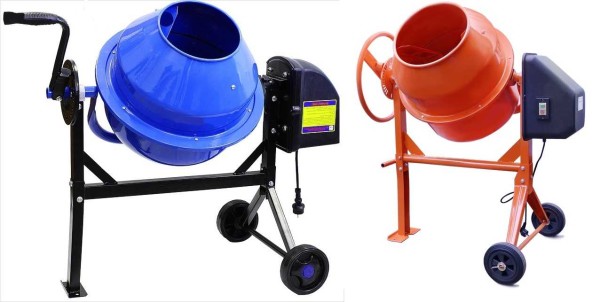
It is more convenient to operate if the swivel mechanism is made in the form of a wheel, and not a lever
Construction details
To finally choose a concrete mixer, go to the details of the structure:
- The concrete container is installed on the bed.The bed must be strong and stable.
- The concrete mixer often needs to be moved around the site. Most models have wheels. It is clear that the larger they are, the easier it will be for you to drag it from place to place.
- The shape of the blades inside the tank. Just welded flat plates are not a good option, curved ones are better.
- Motor guard material. It is made from plastic or painted metal. Metal, of course, is more reliable, but it is not common.
Read how to make a concrete mixer with your own hands here.
Prices and quality
In general, these are all the main points that will help you choose a concrete mixer exactly for your requests and needs. There is still a question of price. As with any product, there are three categories:
- Cheap Chinese concrete mixers. If you pay attention to all the details described above (especially the thickness of the shaft and gear play, as well as the thickness of the metal of the container), it is quite possible that you are lucky and it will work without breakdowns. As a last resort, it will be necessary to grind out worn parts. The main thing is that it should be repaired. The best option is if you find a model with an exchange for the duration of the warranty period. This also happens. Usually all the "shoals" come out in the first year, so the option is really good.
- Medium-priced Russian brands. Usually quite reliable, maybe slightly clumsy. Quite a popular group among those who strive to get reliable equipment for reasonable money.
- European brands. Everyone is good, except for the price and the fact that the problem with spare parts is not always easy to solve - you have to wait several weeks until the right one is delivered. But I must say they are the most reliable.
Reviews
Choosing a concrete mixer by parameters is not all. We still need to decide on the brand, and this can be done mainly according to reviews. This is the only way to get an idea of how reliable or not the units of a particular manufacturer are. There are too many brands of concrete mixers and it is simply unrealistic to give reviews for each brand. We have collected the most popular ones due to the optimal quality and price.
SBR Lebedyanskiy plant
I decided to save money when buying, and bought a BSM concrete mixer (I don't remember exactly which numbers). I made a big mistake when buying. I chose a small volume - something about 50 liters. I had to knead often. Not work, but solid flour. And I still didn't like the design: it was difficult to turn over even a small tank full of solution. Then the drum also fell off. I welded it three times, then I bought a new one - SBR of the Lebedyansk plant. The volume has already taken 130 liters, but it could have been more. It has been working for 5 years. There has been no renovation yet.
Not everyone speaks so about the SBR concrete mixers. There is also a negative experience.
I bought SBR-170 ($ 350). After 10 mixes of mortar (not concrete, but mortar), the seat at the plastic pulley was licked off. I bought a new pulley (about $ 8), put it on, it was enough for another 10 batches. He took off the shaft and gears, gave it to the turners to grind the steel shaft and put the gears on the keys. While Tokaya were working, I bought a Czech stirrer - $ 70 more expensive than the SBR. The pulley is also plastic, but with a larger diameter. So far, from the problems - the strap has screwed up. Both have a cast-iron crown, you need to keep it clean. By the way, the neighbor was also reanimated by replacing the pulley with a self-made one and a better fit of the gears. So I have a negative attitude to this concrete mixer.
There are also positive reviews about the same RBU of the Lebedyansk plant:
I have been plowing a concrete mixer from the Lebedyansk plant for 7 years. I don't remember the brand and volume, but something more than 100 liters. There are no problems with her. Once the foundation was poured from 7 am to 11 pm. I plowed almost without interruption and nothing, survived. During this time, a small gear on the engine was demolished, but it still works.
As you can see, the situation is ambiguous. There are two options.The first is the unstable quality of factory production, the second is the improper operation of the concrete mixer (start with a loaded tank, and not filling into a rotating one).
ProRab (Foreman)
Not always “cheap” means necessarily bad. For example, the Prorab is mostly positive about the very budget line of concrete mixers. Doesn't mean that this tool has no flaws. There are, but they are not critical and they simply turn a blind eye to them, since the price is very small.
I bought a cheap Chinese mixer Prorab (PRORAB) ECM 125. Worked for the season. Basically, I was lucky. She plows normally. Only I don't give a full load, I pour a little more than half, and sometimes I have to push it with my hand. At first I was scared. She almost did not twist, but it turned out that the voltage was 120-140 V. I put the stabilizer, went fine. Has already poured the entire foundation, and this is under 55 tons, so she worked her money (about $ 180). There were some difficulties at the beginning: I had to tighten the belt, as it almost dangled. But since everything is bolted, after loosening the engine mount and the platform to which it is attached, I set everything up so that the tension was ideal. Tightened the bolts, tightened well and that's it.
I have ProRab 160. It has been working for over a year. During this time, he poured the foundation for the barn, warm floors in the house, and constantly made mortar for masonry. A total of 30 cubes are obtained. Only recently has something started to grumble in its teeth, but it has not stopped yet. In general, in the service I saw almost new ones, even with non-peeling paint - their engines are burning. So whoever is lucky.
I rarely take a cheap tool, but based on reviews, I bought a Concrete mixer in Leroy. Despite being cheap, it works fine. Only at full load when unloading the solution can it stop. I have adapted and do not load it completely, and if I see that the motor can hardly pull, they push it a little by hand when unloading. This is already on the machine and no difficulties arise. It makes noise, of course, great, but it doesn't bother too much, and it is also advisable to give it time to cool down - about 10-15 minutes. Since I work "in one hand," such a regime is natural for me.
In general, the reviews are positive. There are certain drawbacks, but they are removable. An excellent inexpensive option for a home or summer cottage.
Profmash
To summarize, the concrete mixers of the Profmash plant are reliable, but heavy and not always easy to use. Some models have “nicknames”: Maxim, Boomer, Behemoth. There are models of gear and crown type. Cast iron or polyamide crowns.
I have a Profmash B130R-MAXIM concrete mixer. Nice car. The tank is thick, attached to the cone, the motor power is 850 watts. For such a small volume (130 l), more than enough. I tried to stop the tank while kneading by hand - it doesn't work. Received the stated amount of solution (80 l). But I don't just use it for concrete. I also feed the mesh. Works great. What's not to like: painted without putty, the paint has already peeled off in places, the start / stop button is inconveniently located. You have to bend over and look under the motor.
I am engaged in construction and I have a team of builders. I buy the tool for them myself. I bought a B-165 and have no regrets. It lasts the longest, despite the tough operating mode. And they treat it - not in the best way: the solution is stuck - they beat it off with a sledgehammer or a hammer. And nothing. It's bad that it is heavy and the wheels are small, the dimensions are still large - it is difficult to climb into the car. But reliability overrides the disadvantages.
Before the start of construction, I bought a B180 Profmash. In principle, it is normal, but it is too difficult to carry her alone around the site. A stubborn leg of some unsuccessful design, I cling to it all the time, the wheels are small. In short, transportation is not for the weak. It is also difficult to flip the tank alone. There is something wrong with the alignment. I thought to load on one side, pour on the other. If it doesn't work, you can't turn the tank over. More: it is stated that 115 liters of batch can be prepared.I have never succeeded, it turns out no more than 80 liters. In general, the score is 4.
Vortex
This brand does not have the best reviews. Strangely, the "sores" are all different.
I bought VORTEX BM-125. The problems started right away: the mine works for 30 minutes and turns off for 20. Again, it grabs for 30 minutes. And this is when the load is far from being full. I gave it to repair, I'm waiting for a miracle.
This is my first concrete mixer Vortex BM-125. What to say. It works and it's good. But the problems began during assembly. The one who completed it, it seems, was drunk: half of the fasteners were missing. I had to go shopping, pick up. Moreover, in the sealing cutter that is placed between the two halves of the tank, there are extra holes, but no necessary ones. I had to make new ones, and through the excess water leaks until everything was mixed. And yet it is much easier to make concrete this way than by hand. Because - I do not regret it.
I have a BM 160. After two months of periodic use, the tank on the axle began to swing. Looks like the bearing is loose. Now the headache is where to fix it.
As you can see, not the best choice.

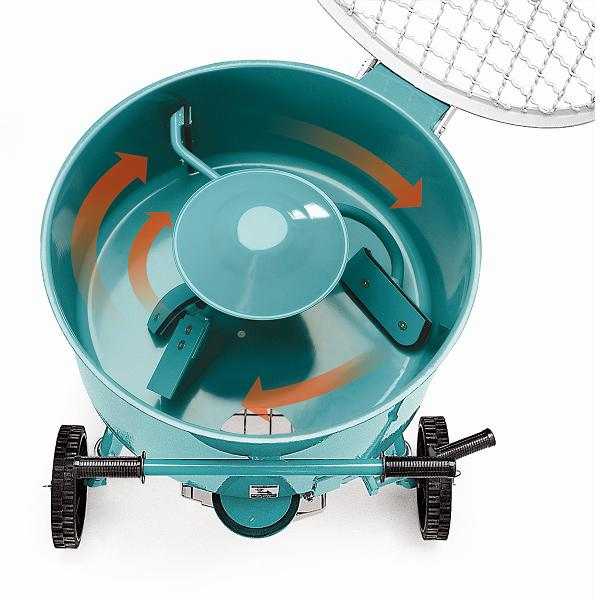
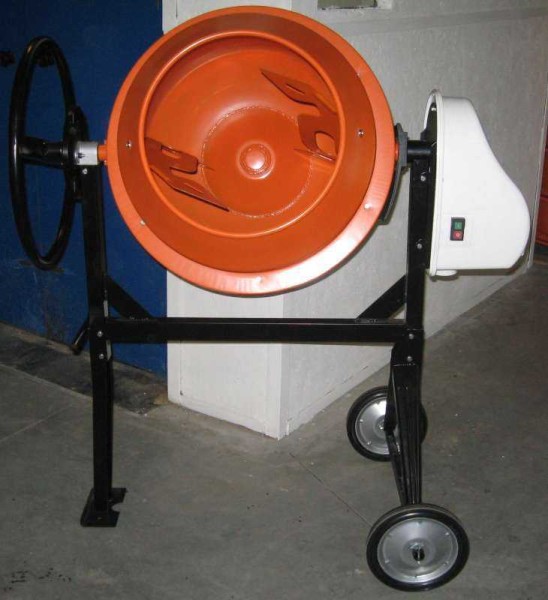
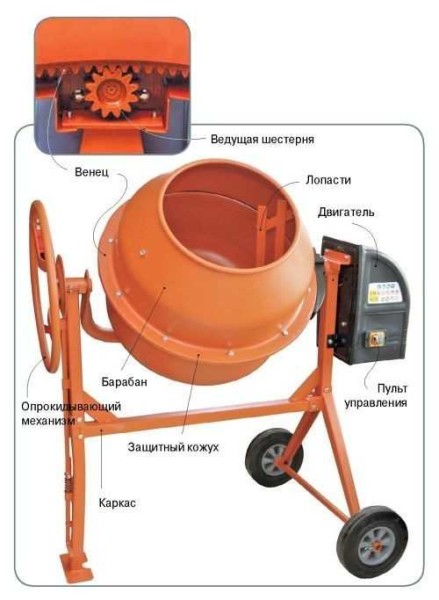
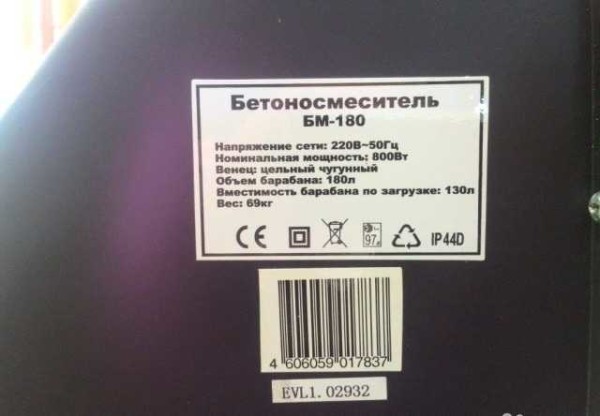
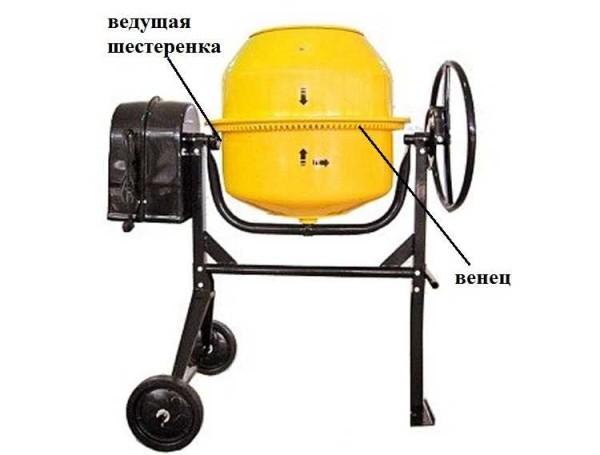
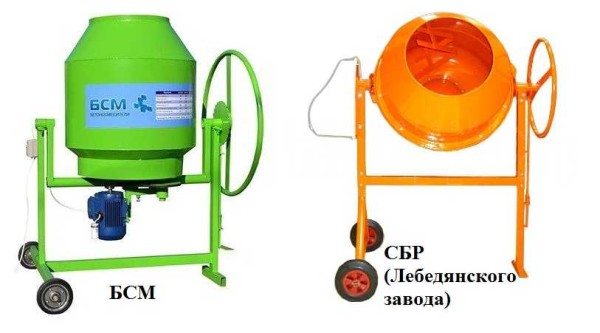

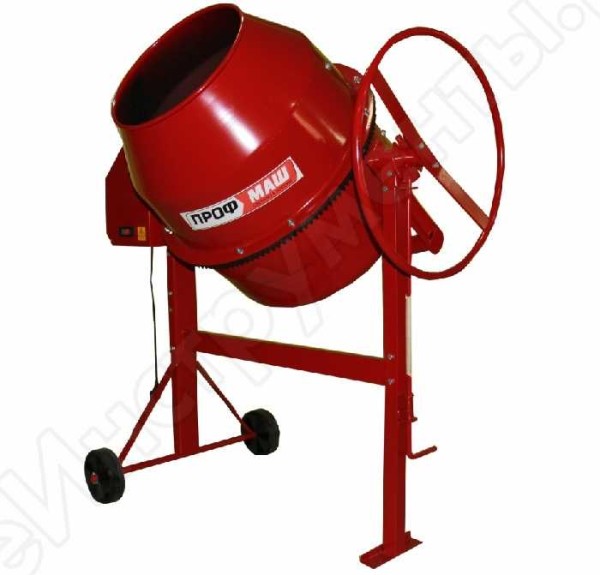
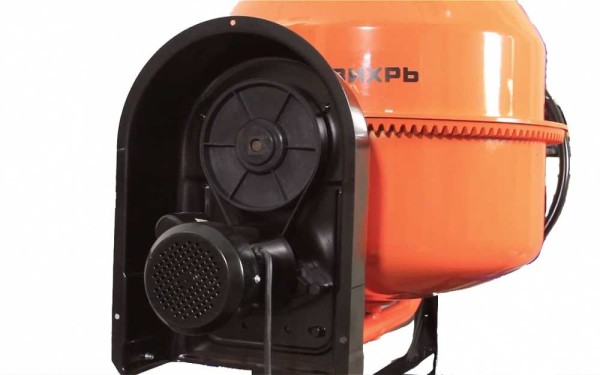
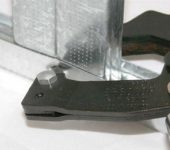
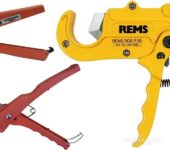
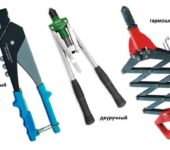







Thanks for the informative article! We took a concrete mixer when laying the foundation of our house